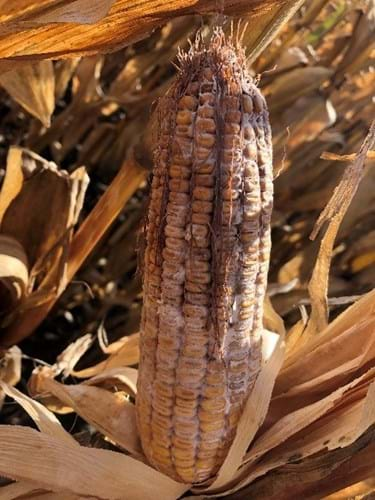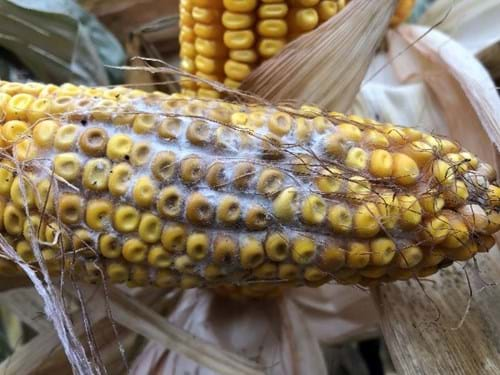Calculating the Disease Impact on Your Crops and Identifying Common Ear Rot
BY Dairyland Seed Agronomy Team
DISEASE IMPACT ON CORN AND SOYBEAN YIELD
It’s that time of year when the days shorten quickly and the air turns cooler. Trees start to show their brilliance and crops dry to a golden brown while forages, lawns and pastures remain green. The diversity in the landscape is strikingly beautiful and fall is in the air!
We hope that our crops dry slowly and naturally, but age brings more susceptibility to diseases that can cut their life short. Universities have valued average national yield losses from corn disease alone to range from $50 to $100 per acre per year. That’s a big deal, but having some late season disease in your crops may not be the doomsday it appears to be at first glance.
Generally speaking, severe yield loss to disease is driven by 1) a critical timing and 2) a critical location on the plant. If we escape these two conditions described below for the diseases, yield loss may not be eliminated, but is greatly reduced. Below is a survey of how some key diseases impact corn and soybean yield. Note that we define yield loss in the most severe cases and also in more typical cases.
Corn
Most of this year’s corn crop had great foliar health well past flowering and into the dent stage which occurs about 30 days later. This is great news for the first bullet point!
- Gray Leaf Spot, Northern Corn Leaf Blight and Goss’s Wilt
- Disease severity is very poorly linked to yield loss. For severe yield loss to occur, blight must begin on or above the ear leaf within two weeks of tassel.
- Severe yield loss from Goss and GLS can approach 50%, while NCLB is closer to 30% loss. 5-20% is much more common.
- Blight arriving during grain fill, especially below the ear, will result in 0-10% loss.
- Can increase the likelihood of stalk disease and lodging.
- Tar Spot
- Premature plant senescence occurs when ear leaf infection is >30% at dent stage, with severe yield loss occurring at >50% infection of the ear leaf at dent.
- While still being studied, most severe cases lead to 20-30% yield loss.
- Can also increase the likelihood of stalk disease and lodging.
- Eyespot
- Often very noticeable, but minimal impact on yield.
- Need >50% infection above the ear; watch for lesions that start running together.
- Stalk Rots: Anthracnose, Fusarium, Gibberella, etc.
- Yield loss a function of the infection rate and reduced ear development, which can be visually estimated as the crop approached black layer.
- Stalk lodging adds to losses as the season progresses.
Soybeans
Soybean diseases are more of a moving target with a more dynamic nature that is harder to define.
- Foliar diseases: Frogeye Leafspot, Septoria Brown Spot, etc.
- Minimal impact on yield if symptoms set in after R5 (beginning seed).
- Severe cases can result in 40% yield loss. ~10% loss is more typical.
- Severity of disease at R6 is usually predictive of yield loss.
- Early season diseases: damping off complex, phytophthora, etc.
- Highly variable: depends on infection rate and timing.
- Neighbor plants can compensate for early season stand loss.
- Sudden Death Syndrome and Brown Stem Rot
- 40-50% yield loss in the most severe cases, 5-15% more typical
- Again, key on infection rates at R6.
- White Mold
- Disease Severity Index (DIX) is a function the % of infected plants and the average severity of infection on each plant (infected branches vs. main stem vs. plant death).
- Yield losses start at a DIX of 25% at R6-7 growth stage
- >10% yield losses tend not to occur until DIX = 65% at R6-7
COMMON EAR ROTS IN CORN
As we walk corn fields at this time of year, a common practice is to examine some sample ears in order to make early yield guesses and monitor grain quality. Sometimes husking ears in the field can yield what causes plant pathologist delight, but can cause corn growers a little bit of concern. And that is finding off-colored and, often times, fuzzy kernels which can be telling signs of ear rot. Common ear rots in the Dairyland Seed footprint are Gibberella, Diplodia, and Aspergillus.
Giberella Ear Rot, Giberella zeae, is most easily Identified as pink or red “fuzzy” fungal bodies on and between kernels with infection beginning at the tip. Infection generally occurs during cooler periods 2-3 weeks after silking. Giberella over winters in corn residue as well as wheat residue that was infected with Fusarium Head Blight as it is the same pathogen. Large scale infections of Giberella can cause grain quality issues by producing mycotoxins such as Deoxynivalenol or DON and vomitoxin. These mycotoxins can cause issues when fed to animals especially swine. Testing of suspect grain is preformed to determine levels of DON.

Diplodia Ear Rot, Stenocarpella maydis, is usually gray or white fungal bodies that appear between kernels and can appear at any part of the ear, but infection usually begins at the base of the ear. Small black structures called pycnidia can also be found between kernels, husks or in the cob. Diplodia impacted grain will can have lower test weight and, in severe cases, can cause storability issues. The pathogen overwinters in corn debris so no-till corn back to corn situations with dry conditions prior to silking and wet conditions after silking are at highest risk. Tillage or rotation away from corn will help reduce Diplodia in the soil.

Aspergillus Ear Rot, Aspergillus flavus, is identified by powdery olive-green fungal structures often accompanied with white or black structures as well. Hot and dry growing conditions with otherwise stressed plants, favor infection. Aspergillus creates a mycotoxin in the kernel called aflatoxin. Aflatoxin is harmful can cause a number of health issues for animals if large amounts of grain are infected. Stress mitigation through proper fertility as well as drought tolerant hybrid selection can help reduce chances of infection.
This article is not meant to incite fear and panic, but to be a tool to help recognize ear molds should they appear in your corn fields. If you have any questions regarding these or other ear molds, please contact your Dairyland Seed DSM or Regional Agronomist for more information.
ELITE PRODUCER CLUB
Join Dairyland Seed’s Elite Producer Club by submitting photos or testimonials of high performing products! Simply text a picture or testimonial of your high performing products to 913-DS-YIELD or 913-379-4353. The program runs from August 15 through December 1, 2021.
Participants will receive a free Dairyland Seed t-shirt (one per entry) and “Elite Yield Club” Certificate. All corn grain, corn silage and soybean products are eligible.
Qualifying products for “Elite Yield” Contest (one winner per family, per region, prize is 3 free units of product that was entered):
Region 1 = DS-3366 family; DS-3550 family; DS-4018 family
Region 2 = DS-3550 family; DS-4018 family; DS-4878 family; DS-5144Q
Region 3 = DS-4310 family; DS-4878 family; DS-5144Q
Region 4 = DS-3366 family; DS-3550 family; DS-4014Q; DS-4310 family
Information required in text: Participant; Location; Product; Yield in Bushels or Tons; T-Shirt Size; DSM; Mailing address if different than participant.
 |
 |
 |
 |
 |
| Brian Weller Western Region 507.456.3034 |
Dan Ritter Central Region 219.863.0583 |
Branden Furseth Northern Region 608.513.4265 |
Mark Gibson Eastern Region 260.330.8968 |
Amanda Goffnett Eastern Region 989.400.3793 |
